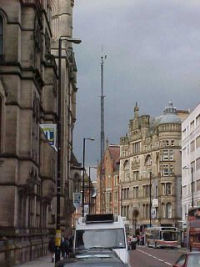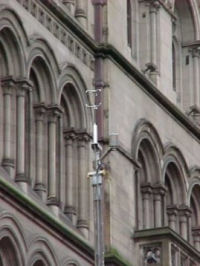SCAR (Street Canyon Aerosol Research)

Project Overview
Aerosol particles are released into the atmosphere in huge numbers by road vehicles. When inhaled these particles can cause respiratory health problems and so they are considered to be a pollutant. The urban ‘street canyon’, where city streets are lined on both sides by buildings of 3 or 4 floors or more, is the environment into which much of this aerosol is released and where many people are exposed to the pollutant. The presence of the buildings forces the wind to blow in turbulent eddies which partially traps airborne pollutants within the ‘canyon’, preventing their dispersion, and sometimes giving rise to high concentrations. However, very little is currently known about how much aerosol is actually released into the canyon air and how much is trapped, and what these values depend upon.
The objective of SCAR was to measure these turbulent eddies, along with concentrations of airborne pollutants within a street canyon, and to use this data to calculate the rate at which aerosol particles are ventilated from the canyon space. The influence of meteorological factors such as wind speed and direction, and solar radiation will be determined.
SCAR consisted of several short measurement campaigns within the streets of central Manchester, conducted throughout 2001. Measurements of aerosol concentration were made with three different instruments which counted particles in a sum of 150 different size bins, from 4.6 nm to 32 microns. Measurements were made with at least 1 minute resolution, averaged to 10 minutes for most of the analysis. Routine monitoring measurements are usually presented at an hourly resolution or longer. The aerosol measurements were made alongside measurements of wind speed, direction and turbulence using fast ultrasonic anemometers. Other pollutants, such as oxides of nitrogen, are also measured. This allowed a detailed analysis of how the steady and gusty air flow in the street canyon was influencing the variation in aerosol concentration. For the first time in a street canyon, the technique of eddy covariance was attempted to directly measure the vertical turbulent emission flux from the canyon.

Summary of Results
- Airflow was mostly channelled within the canyon. Wind speed at street level was linearly related to that at a roof-top reference level, EXCEPT during perpendicular flow when wind speeds were de-coupled.
- A simple model was fitted to vertical profiles of sigma u, v and w.
- A strong influence of traffic was found on sigma w at 2 m height.
- Coarse and fine mode particle concentrations were mostly independent.
- Concentrations of ultrafine particles typically exceeded urban background levels by a factor of 2, although this factor increased dramatically in perpendicular flow, due to the instruments being immediately downwind of traffic sources.
- Accumulation mode particles were related to in-canyon and extra-canyon sources giving less dependence upon in-canyon airflow.
- Vertical turbulent fluxes of fine mode particles followed a diurnal cycle with a peak in the middle of the day.
- A negative vertical gradient in fluxes and concentrations was found.
Publications
Longley, I.D., Gallagher, M.W., Dorsey, J.R., Flynn, M., Allan, J.D., Alfarra, M.R., Inglis, D. A case-study of aerosol (4.6nm<Dp<10µm) number and mass size distribution measurements in a busy street canyon in Manchester , U.K. Atmospheric Environment 37, 1563-1571. 2003.
Longley, I.D., Gallagher, M.W., Dorsey, J.R., Flynn, M., Barlow, J.F., Short-term measurements of airflow and turbulence in two street canyons in Manchester. Atmospheric Environment, 38, 69-79. 2004
Longley, I.D., Gallagher, M.W., Dorsey, J.R., Flynn, M. A case-study of fine particle concentrations and fluxes measured in a busy street canyon in Manchester , UK. Atmospheric Environment, 38, 3595-3603. 2004
Longley, I.D. Corrections to a description of turbulence in a trafficked street canyon in Manchester. Atmospheric Environment, 38, 4589-4592. 2004.